stimulants and bipolar disorder
 How to reduce mania risk when prescribing stimulants | MDedge Psychiatry
How to reduce mania risk when prescribing stimulants | MDedge PsychiatryAssociate Ad Index Part of a Collection: Use of stimulants in bipolar disorders volume 19, article number: 7 (2017) Volume 192905 Accesses12 Citations2 AltmetricAbstractThe various international guidelines indicate stimulants, including methylphenidate (MPH), amphetamines and derivatives, fashionfinil and armodafinil among the second-line options for bipolar depression. The effectiveness of stimulants for managing residual depressive symptoms such as fatigue and drowsiness and for managing affective, cognitive and behavioral symptoms in children and adult bipolar patients with comorbid ADHD has also been reported. Few case reports show positive results with MPH in the treatment of resistant mania. Finally, MPH could be an option in some bipolar forms observed in psychiatric presentations of frontotemporal dementia and traumatic brain injury. Despite these preliminary observations, the use of stimulants in bipolar patients remains controversial. Potential of misuse and abuse and mood destabilization with induction of (hypo)manic switches, mixed states, and rapid bike are the concerns most frequently reported. Our objectives are to summarize the literature available on this topic and discuss practical management implications. This is a preview of the subscription content, access options Buy single itemInstant access to the full PDF article. 34,95 €The calculation of the box will be completed during checkout. Subscribe to the journalImediate online access to all problems since 2019. The subscription will be renewed annually. 73,83 €The tax calculation will be completed during checkout. ReferencesPapers of particular interest, recently published, have been highlighted as: • Important ••• Important Sonders MS et al. Multiple ionic behaviors of the human dopamine conveyor: the actions of dopamine and psychostimulants. J Neurosci. 1997;17(3):960–74. Schmitt KC, Reith ME. Nootropic atypical and fashionable stimulant interacts with dopamine conveyor in a different way than classic cocaine inhibitors. PLoS One. 2011;6(10):e25790. Minzenberg MJ, Carter CS. Modafinil: a review of neurochemical actions and effects in cognition. Neuropsychopharmacology 2008;33(7):1477–502. Vosburg SK et al. Modafinil does not serve as a boost in cocaine users. Drug alcohol Depends. 2010;106(2-3):233–6. Neubauer H, Bermingham P. Lithium-sensitive depressive syndrome. Analysis of 20 cases. J Nerv Ment Dis. 1976;163(4):276–81. Sharma V, Khan M, Smith A. A closer look at treatment-resistant depression: is it due to bipolar diathesis? J Affect Disord. 2005;84(2-3):251-7. Wharton RN et al. A possible clinical use for methylphenide with tricyclic antidepressants. I'm J Psychiatry. 1971;127(12):1619-25. Wingo AP, Ghaemi SN. A systematic review of the rates and the diagnostic validity of the adult comorbid disorder of care-deficit/hyperactivity and bipolar disorder. J Clin Psychiatry. 2007;68(11):1776–84. Perugi G, Vannucchi G. The use of stimulants and atomoxetine in adults with comorbid ADHD and bipolar disorder. Expert Opin Pharmacother. 2015;16(14):2193-204. Grunze H et al. World Federation of Biological Psychiatry Societies (WFSBP) Guidelines for the Biological Treatment of Bipolar Disorders: 2010 update on the treatment of acute bipolar depression. World J Biol Psychiatry. 2010;11(2):81–109. Yatham LN et al. Canadian Network for Mood and Anxiety Treatments (CANMAT) and International Society for Bipolar Disorders (ISBD) collaborative update of CANMAT guidelines for the management of patients with bipolar disorder: update 2009. Disord bipolar. 2009;11(3):225-55. Frye MA et al. Adjunctive placebo-controlled evaluation in the treatment of bipolar depression. Am J Psychiatry. 2007;164(8):1242-9. Calabrese JR et al. Adjunctive armodafinil for major depressive episodes associated with bipolar disorder I: a randomized, multicentered, double-blind, placebo-controlled, concept test. J Clin Psychiatry. 2010;71(10):1363–70. McElroy SL et al. Adjunctive lisdexamphetamine in bipolar depression: a randomized, placebo-controlled trial. Int Clin Psychopharmacol. 2015;30(1):6–13. Silberman EK et al. Heterogeneity of the response to amphetamine in depressed patients. I'm J Psychiatry. 1981;138(10):1302-7. Reus VI et al. d-Amphetamine: effects on memory in a depressed population. Biol Psychiatry. 1979;14(2):345–56. Calabrese JR et al. Adjunctive armodafinil efficiency and safety in adults with major depressive episodes associated with bipolar disorder I: a randomized, double-blind, placebo-controlled, multicentered trial. J Clin Psychiatry. 2014;75(10):1054-661. Bond DJ et al. The Canadian Network on Mood and Anxiety Treatments (CANMAT) recommendations of the task force for the management of patients with mood disorders and comorbid disorder of care/hyperactivity deficit. Ann Clin Psychiatry. 2012;24(1):23–37. El-Mallakh RS. Open study of methylphenidate in bipolar depression. Bipolar disorder. 2000;2(1):56–9. Findling RL et al. Methylphenidate in the treatment of children and adolescents with bipolar disorder and care-deficit/hyperactivity disorder. J Am Acad Child Adolesc Psychiatry. 2007;46(11):1445–53. Scheffer RE et al. Random and placebo-controlled trial of mixed amphetamine salts for symptoms of comorbid ADHD in pediatric bipolar disorder after mood stabilization with divalproex sodium. Am J Psychiatry. 2005;162(1):58–64. Biederman J et al. A longitudinal course of deficient emotional self-regulation CBCL profile in young people with ADHD: prospective controlled study. Neuropsychiatrist Dis Treat. 2012;8:267–76. Carlson PJ, Merlock MC, Suppose T. Adjunctive stimulant use in patients with bipolar disorder: treatment of residual depression and sedation. Disord bipolar. 2004;6(5):416–20. Parker G, Brotchie H. Do old psycho-stimulant drugs have a role in managing treatment-resistant depression? Acta Psychiatr Scand. 2010;121(4):308–14. McIntyre RS et al. The effect of lisdexamphetamine dimesylate on body weight, metabolic parameters and the attention deficit of hyperactivity symptomatology in adults with bipolar disorder I/II. Hum Psychopharmacol. 2013;28(5):421-7. Nasr S. Modafinil as adjunctive therapy in depressed external patients. Ann Clin Psychiatry. 2004;16(3):133-8. Nasr S, Wendt B, Steiner K. Absence of mood switch with and tolerance to modafinil: a replication study from a large private practice. J Affect Disord. 2006;95(1-3):111-4. Dell'osso B et al. Adjunctive chronic upper fashion tolerance compared to pramipexol in treatment-resistant bipolar disorder. J Affect Disord. 2013;150(1):130-5. Lydon E, El-Mallakh RS. Long-term natural use of methylphenidate in bipolar disorder. J Clin Psychopharmacol. 2006;26(5):516-8. Wingo AP, Ghaemi SN. Frequency of stimulant and mania/hypomany treatment associated with stimulants in patients with bipolar disorder. Psychopharma bull. 2008;41(4):37–47. • Parker G et al. Psychostimulants for the management of unipolar and bipolar melancholic depression: a medium-term evaluation of cost benefits. J Affect Disord. 2013;151(1):360-4. A systematic report on the effectiveness of stimulant drugs in a large sample of bipolar patients. A systematic report on the effectiveness of stimulant drugs in a large sample of bipolar patients Adida M, Azorin JM. Efficacy of methylphenide as an increase therapy after failure of adjunctive neuromodulation for patients with bipolar depression refractory to treatment: a case report. Neuropsychiatrist Dis Treat. 2014;10:559–62. Bajwa WK et al. Catatony management in bipolar disorder with stimulants. Case Psychiatry. 2015;2015:423025. Menza MA, Kaufman KR, Castellanos A. Modafinil increase in antidepressant treatment in depression. J Clin Psychiatry. 2000;61(5):378–81. Fernandes PP, Petty F. Modafinil for bipolar depression referred with hypersomnia. Ann Pharmacother. 2003;37(12):1807-9. Guerdjikova AI, McElroy SL. Adjunctive methylphenidate in the treatment of bulimia nervosa co-occurring with bipolar disorder and dependence on substances. Innov Clin Neurosci. 2013;10(2):30-3. Halmoy A et al. Bipolar symptoms in adult care deficit disorder/hyperactivity: a cross-sectional study of 510 patients clinically diagnosed and 417 demographic controls. J Clin Psychiatry. 2010;71(1):48–57. McIntyre, R.S., et al., Disorder of care/hyperactivity deficit in adults with bipolar disorder or major depressive disorder: results of the collaborative project of international mood disorders. Prim Care Companion J Clin Psychiatry, 2010. 12(3). 12Nierenberg AA et al. Clinical and diagnostic consequences of care/hyperactivity disorder throughout life comorbidity in adults with bipolar disorder: data from the first 1000 participants in STEP-BD. Biol Psychiatry. 2005;57(11):1467–73. Ryden E et al. A history of poor hyperactivity disorder of child care (ADHD) affects the clinical outcome in adult bipolar patients, regardless of current ADHD. Acta Psychiatr Scand. 2009;120(3):239–46. Skirrow C et al. An update of the association of debate between ADHD and bipolar disorder throughout the lifespan. J Affect Disord. 2012;141(2-3):143–59. Tamam L, Karakus G, Ozpoyraz N. Comorbidity of adult attention-deficit hyperactivity disorder and bipolar disorder: prevalence and clinic correlates. Eur Arch Psychiatry Clin Neurosci. 2008;258(7):385–93. Wender PH, Wolf LE, Wasserstein J. Adults with ADHD. A general vision. Ann N Y Acad Sci. 2001;931:1-16. Mosholder AD et al. Alucinations and other psychotic symptoms associated with the use of care disorder drugs and hyperactivity in children. Pediatrics. 2009;123(2):611-6. Viktorin, A., et al., The risk of an emerging mania with methylphenidate in bipolar disorder. AJP, 2016. in press. Kraemer M et al. Psychosis induced by methylphenidate in the disorder of adult care/hyperactivity: report of 3 new cases and review of literature. Clin Neuropharmacol. 2010;33(4):204–6. Ross RG. Psychotic and manic symptoms during the stimulating treatment of hyperactivity disorder of the care deficit. Am J Psychiatry. 2006;163(7):1149–52. Spensley J. Folie a deux with metilphenidate psychosis. J Nerv Ment Dis. 1972;155(4):288-90. Spensley J, Rockwell DA. Psychosis during the abuse of methylphenidate. N Engl J Med. 1972;286(16):880–1. Young JG. Methylphenidate-induced alucinnosis: case stories and possible action mechanisms. J Dev Behav Pediatr. 1981;2(2):35-8. Schneider BN, Enenbach M. Managing the risks of ADHD treatments. Curr Psychiatry Rep. 2014;16(10):479. Hegerl U, Hensch T. The model of monitoring of affective disorders and ADHD. Neurosci Biobehav Rev. 2014;44:45–57. Hegerl U et al. Mania and Attention Deficit/hyperactivity Disorder: Common Syntomatology, Common Physiopathology and Common Treatment? Curr Psychiatry Opin. 2010;23(1):1-7. Hegerl U et al. Is psychostimulants an option to treat in mania? Pharmacopsychiatry. 2009;42(5):169–74. Brown WA, Mueller B. Relief of manic symptoms with catecholamine agonists. I am J Psychiatry. 1979;136(2):230–1. Clower CG. Treatment of mania with dextroanphetamine. J Clin Psychiatry. 1988;49(7):283. Garvey MJ et al. Treatment of dextroamphetamine of mania. Psychiatry of J Clin. 1987;48(10):412-3. Max JE, Richards L, Hamdan-Allen G. Case study: antimanic effectiveness of dextroanphetamine in a teenager injured by the brain. J Am Acad Child Adolesc Psychiatry. 1995;34(4):472-6. Bschor T, Muller-Oerlinghausen B, Ulrich G. Reduced level of EEG surveillance in acute mania as a possible predictor of a rapid effect of methylphenidate: a case study. Clin Electroencephalogr. 2001;32(1):36-9. Schoenknecht P et al. Acute mania treatment with fashionable monotherapy. Biol Psychiatry. 2010;67(11):e55-7. Kluge M et al. Methylpheniate in Mania Project (MEMAP): a study protocol for a double-blind, placebo-controlled international randomized study on the initial treatment of acute mania with methylphenidate. BMC Psychiatry. 2013;13. Ng B et al. A series of cases on hypothesized connection between dementia and bipolar spectrum disorders: bipolar type VI? J Affect Disord. 2008;107(1-3):307-15. Van Gerpen MW, Johnson JE, Winstead DK. Mania in the population of geriatric patients: a literature review. Am J Geriatr Psychiatry. 1999;7(3):188–202. Tohen M, Shulman KI, Satlin A. First-episode mania in late life. I am J Psychiatry. 1994;151(1):130–2. Fujikawa T, Yamawaki S, Touhouda Y. Silent brain infarctions in patients with late mania. Stroke. 1995;26(6):946-9. Robinson RG et al. Comparison of mania and depression after brain injury: causal factors. Am J Psychiatry. 1988;145(2):172-8. Graham, A. and J. Hodges, Pick's disease: his relationship with progressive aphasia, semantic dementia and frontotemporal dementia, in dementia, A. Burns, J. O'Brien, and J. Ames, Editors. 2005, Hodder Arnold: London. p. 678-688.Rahman S et al. Methylphenidate ('Ritalin') can improve abnormal risk behavior in the front variant of the frontal dementia. Neuropsychopharmacology. 2006;31(3):651-8. Goforth HW et al. Quantitative electroencephalography in frontal dementia with methylphenide response: a case study. Clin EEG Neurosci. 2004;35(2):108-11. Seamans JK et al. Bidirectional modulation of GABAergica inhibition dopamine in prefrontal pyramidal neurons. J Neurosci. 2001;21(10):3628-38. McAllister TW et al. Randomized, placebo-controlled study of methylphenidate or galantamine for persistent emotional and cognitive symptoms associated with PTSD and/or traumatic brain injury. Neuropsychopharmacology. 2016;41(5):1191-8. Mooney GF, Haas LJ. Effect of methylphenide in anger related to brain injury. Arch Phys Med Rehabil. 1993;74(2):153–60. Schumann G et al. Stratified medicine for mental disorders. Eur Neuropsychopharmacol. 2014;24(1):5–50. Fountoulakis KN et al. Ultra short maniac-like episodes after antidepressant exacerbation with fashionfinil. Prog Neuropsychopharmacol Biol Psychiatry. 2008;32(3):891–2. Maremmani I et al. Urine stabilizers in the treatment of substance use disorders. CNS Spectr. 2010;15(2):95–109. Plant DT. Emerging treatment-hypomany or mania with fashionfinil. Am J Psychiatry. 2008;165(1):134-5. author reply 135. DelBello MP et al. Previous stimulant treatment in teens with bipolar disorder: association with age at the beginning. Disord bipolar. 2001;3(2):53-7. Soutullo CA et al. Severity of bipolarity in hospitalized maniac adolescents with a history of stimulant or antidepressant treatment. J Affect Disord. 2002;70(3):323-7. Castaneda R et al. Treatment of hyperactivity disorder of adult care deficit in hospitalized psychiatric patients. Gen Hosp Psychiatry. 2008;30(6):572-7. Hamrin V, Bailey K. Gabapentin and methylphenidate treatment of a preteen with hyperactivity disorder of the attention deficit and bipolar disorder. J Child Adolesc Psychopharmacol. 2001;11(3):301–9. Ballon JS, Feifel D. A systematic review of fashionfinil: potential clinical uses and action mechanisms. J Clin Psychiatry. 2006;67(4):554–66. •• Asherson P et al. Differential diagnosis, comorbidity and treatment of care-deficit/hyperactivity disorder in relation to bipolar disorder or border personality disorder in adults. Curr Med Res Opin. 2014;30(8):1657–72. A review that explores widely the issues of diagnosis and treatment on the overlap/comorbidity between bipolar disorder, border personality and ADHD. A review that explores widely the issues of diagnosis and treatment on the overlap/comorbidity between bipolar disorder, border personality and ADHD Scheffer RE. ADHD and bipolar disorder. Curr Psychiatry Rep. 2007;9(5):415-9. Author's informationAfiliationsDepartment of Experimental and Clinical Medicine, Psychiatry Section, University of Pisa, Via Roma 67, 56100, Pisa, ItalyGiulio PerugiInstitute of Behavioural Science "G.De Lisio", Pisa, ItalyGiulio PerugiDipartimento di Neuroscienze, Psychologia, Area del Farmaco e Salute del Bambinonu Hospital You can also search this author in You can also search this author in You can also search this author in Correspondence to the correspondent .Ethic declarations Conflict of interest The authors declare that they have no conflict of interest. Human and animal rights and informed consent This article does not contain studies with human subjects or animals carried out by any of the authors. Additional Information This article is part of the Topic Collection of Bipolar Disorders Rights and permits About this article Cite this articlePerugi, G., Vannucchi, G., Bedani, F. et al. Use of stimulants in bipolar disorder. Curr Psychiatry Rep 19, 7 (2017). https://doi.org/10.1007/s11920-017-0758-x19, Published: 01 February 2017DOI: KeywordsAssociated Index Part of a Collection: Access OptionsBuy a single itemConstant access to the full PDF article. 34,95 €The calculation of the box will be completed during checkout. Subscribe to the journalImediate online access to all problems since 2019. The subscription will be renewed annually. 73,83 €The tax calculation will be completed during checkout. Announcement More than 10 million scientific documents available Not connected - 54.179.187.232 Not affiliated © 2021 Springer Nature Switzerland AG. Part of .
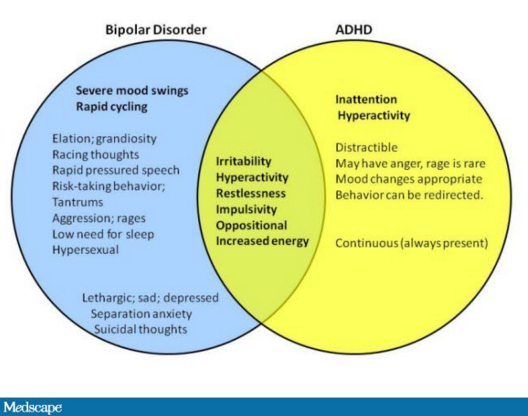
ADHD and Bipolar Disorder in Children | APSARD

Stimulant Use | Dual Diagnosis
Gale Academic OneFile - Document - Stimulants for adult bipolar disorder? Adding a stimulant could improve residual symptoms, but it also might cause serious side effects, toxicities, and destabilization
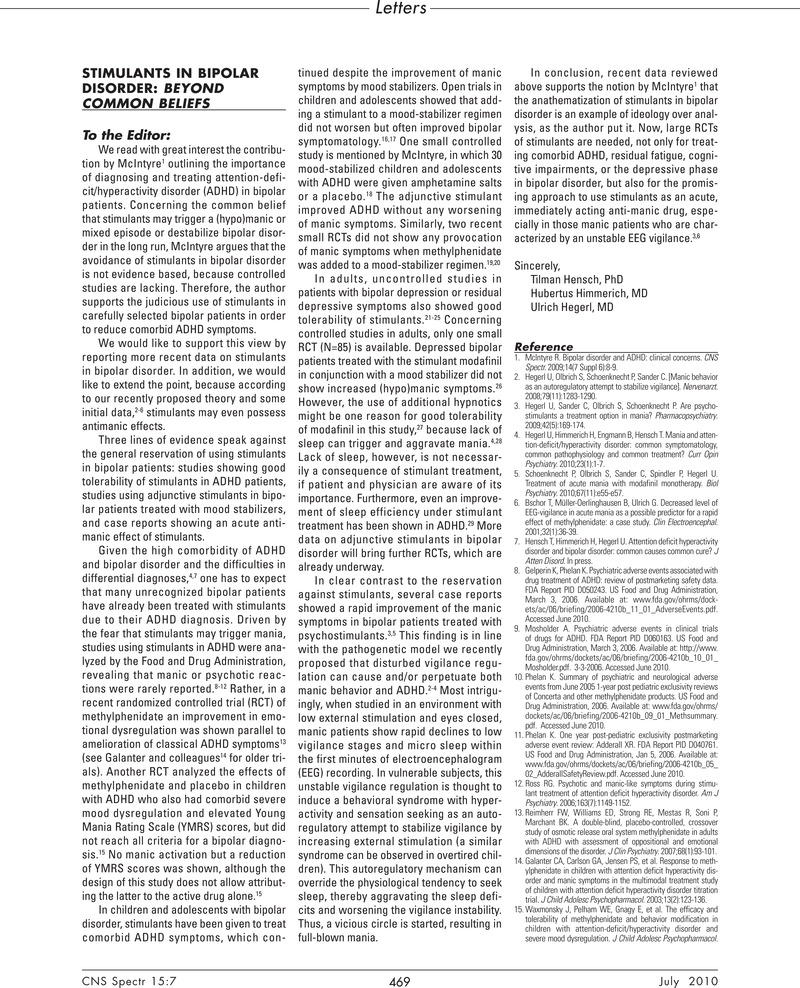
Stimulants in Bipolar Disorder: Beyond Common Beliefs | CNS Spectrums | Cambridge Core

Are we close to understanding bipolar disorder? | The Japan Times

Bipolar Disorder Guidelines for Management - RANZCP & BAP
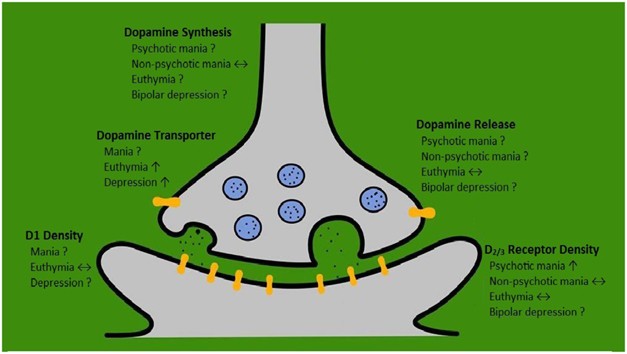
The dopamine hypothesis of bipolar affective disorder: the state of the art and implications for treatment | Molecular Psychiatry

Cognition, Bipolar Disorder, and the Self
Gale Academic OneFile - Document - Stimulants for adult bipolar disorder? Adding a stimulant could improve residual symptoms, but it also might cause serious side effects, toxicities, and destabilization
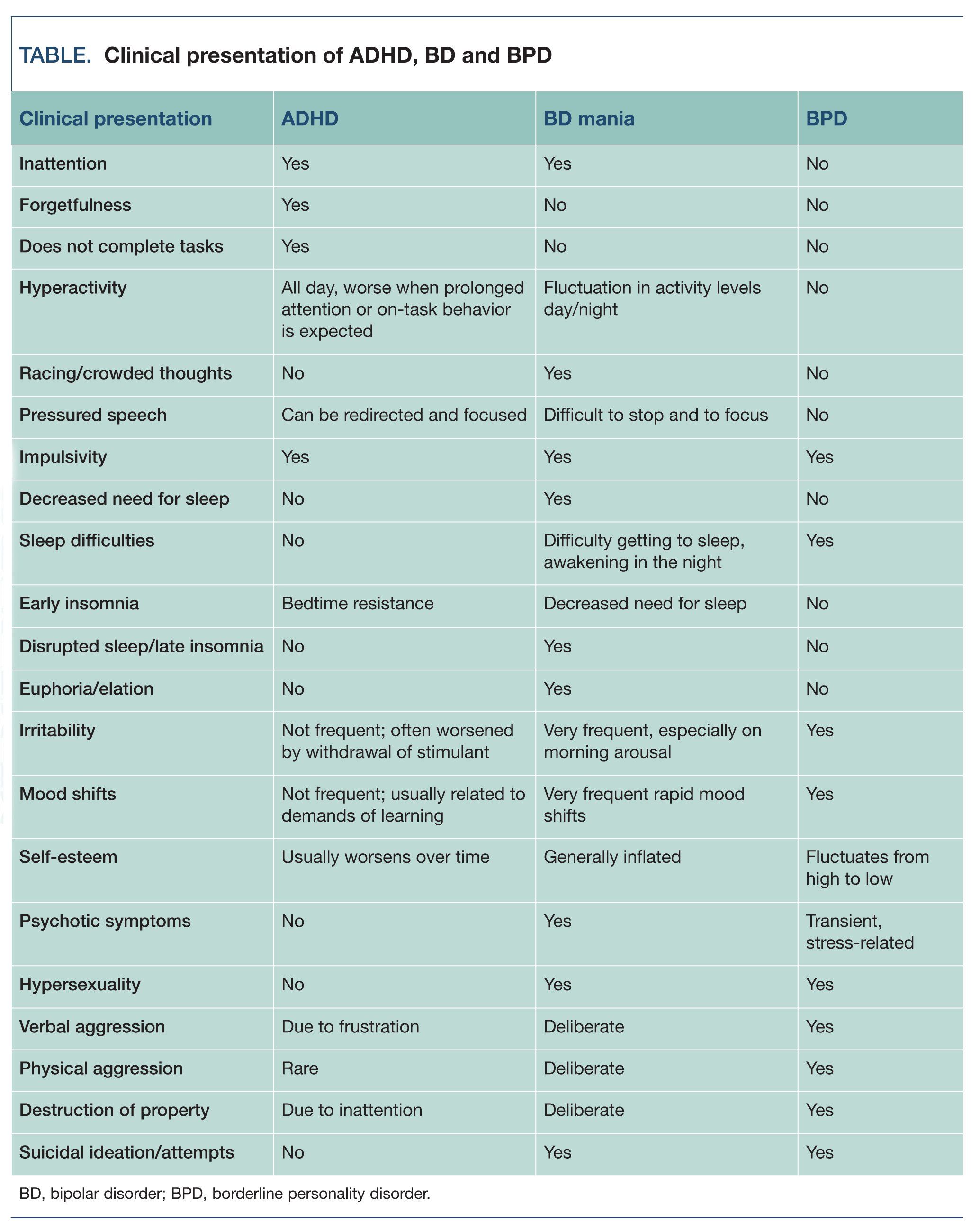
ADHD, Bipolar Disorder, or Borderline Personality Disorder

PDF) Use of adjunctive stimulants in adult bipolar depression
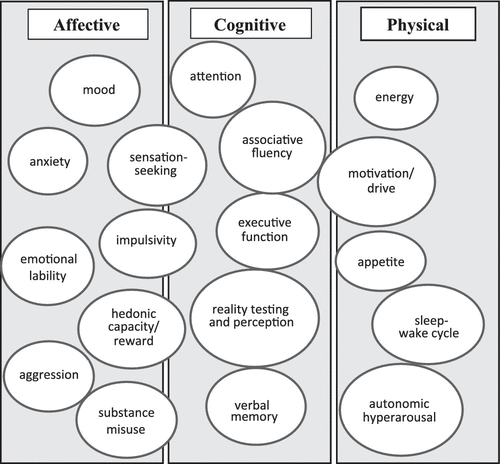
Complex Combination Pharmacotherapy for Bipolar Disorder: Knowing When Less Is More or More Is Better | FOCUS

PDF) Use of adjunctive stimulants in adult bipolar depression
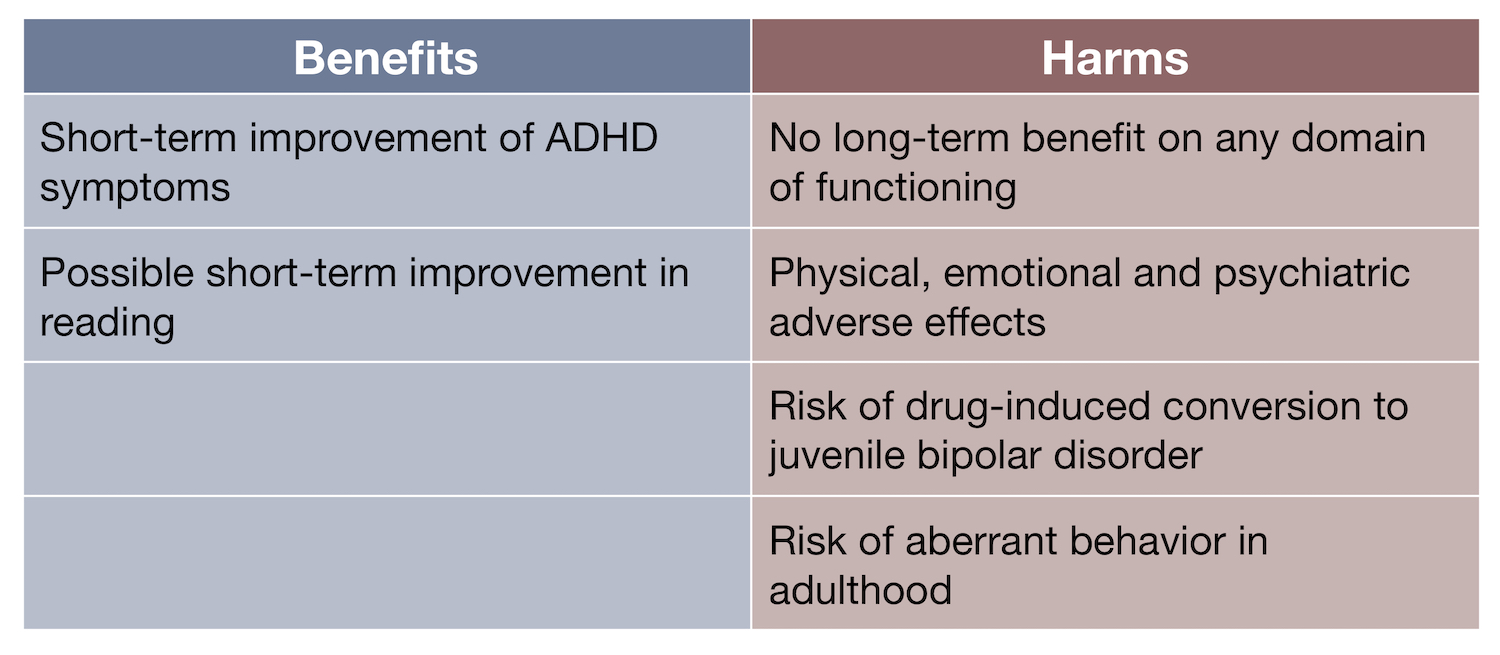
ADHD Drug Info - Mad In America

How to prevent the malignant progression of bipolar disorder

ADHD vs Bipolar: Guide to Distinguishing Lookalike Conditions

Central Nervous System Stimulants, Suicide, Bipolar Disorder & ADHD
![PDF] Use of adjunctive stimulants in adult bipolar depression. | Semantic Scholar PDF] Use of adjunctive stimulants in adult bipolar depression. | Semantic Scholar](https://d3i71xaburhd42.cloudfront.net/ee5dbcc1203061fcec183cf8d94c88849eaf3a58/8-Table3-1.png)
PDF] Use of adjunctive stimulants in adult bipolar depression. | Semantic Scholar

Bipolar Disorder Guidelines for Management - RANZCP & BAP
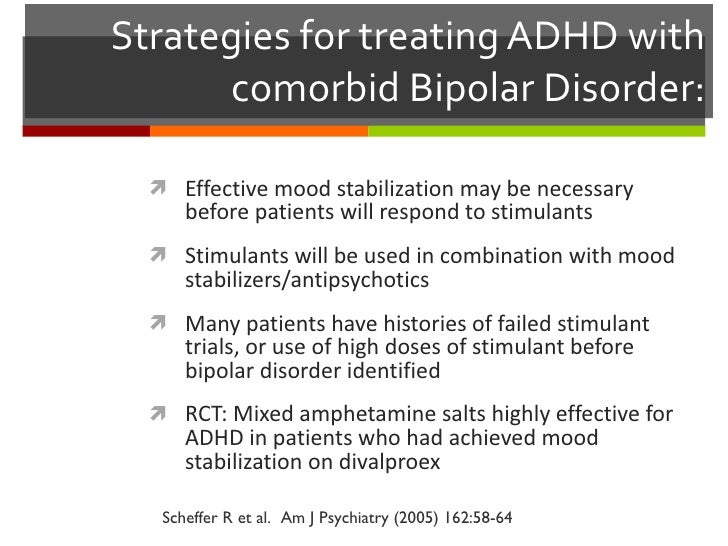
Treatment Of Pediatric Bipolar Disorder 82010

Stimulants May Reduce Self-Injury in Patients with Bipolar Disorder and Comorbid ADHD - Psychiatry Advisor

Cyclothymia - Wikipedia

The ADHD and Bipolar Disorder Connection
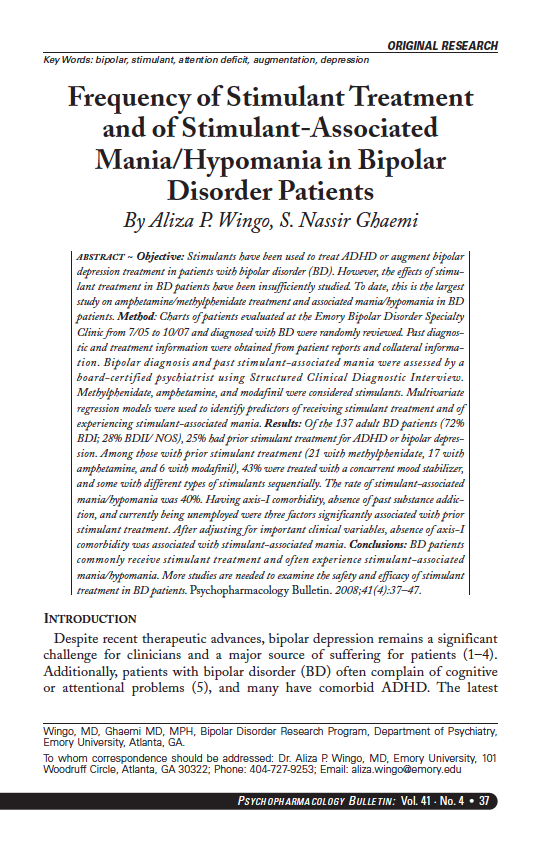
Aliza P.Wingo - Frequency of Stimulant Treatment and of Stimulant-Associated Mania/Hypomania in Bipolar Disorder Patients

Central Stimulants May Reduce Suicide Risk in Adults With Bipolar Disorder and ADHD | Psychiatry & Behavioral Health Learning Network

Use of Stimulants in Bipolar Disorder | Request PDF
Suicidal and non-suicidal self-injurious behaviour in patients with bipolar disorder and comorbid attention deficit hyperactivit
The Highs and Lows of Treating Bipolar Disorder - Dr. Farrar

Adderall for Bipolar Disorder: Potential Side Effects
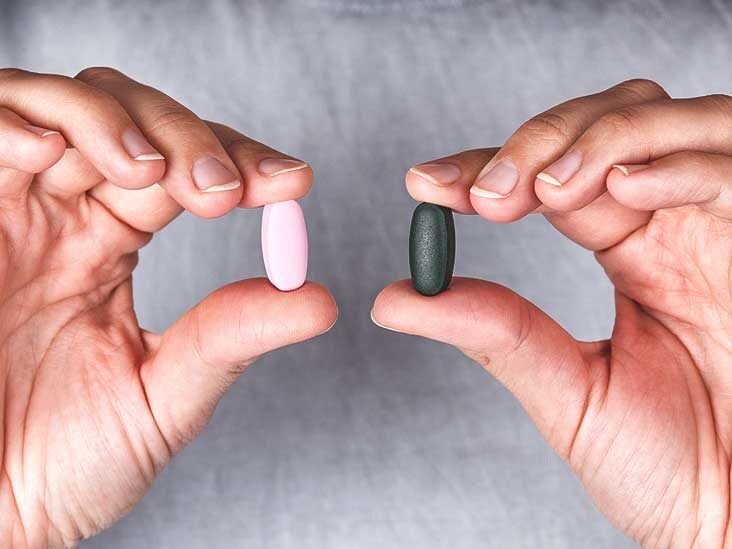
Adderall for Bipolar Disorder: Potential Side Effects
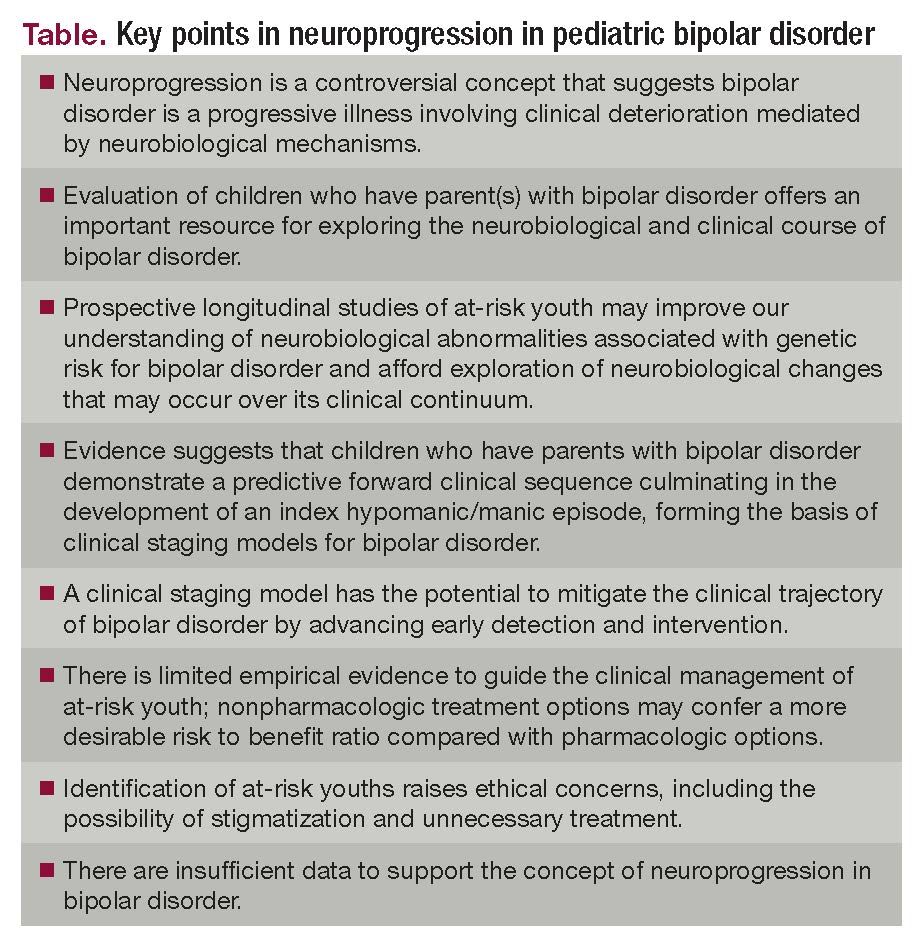
Neuroprogression of Bipolar Disorder in Children and Adolescents

Bipolar and ADHD...Together? An Expert Explains The Signs
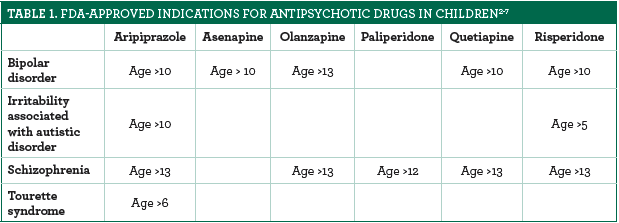
Antipsychotics for Children With ADHD Should Be a Last Resort

Bipolar Disorder Foods to Avoid | Everyday Health

Do Stimulants Cause Bipolar Mania in Children and Teens? | Global Medical Education
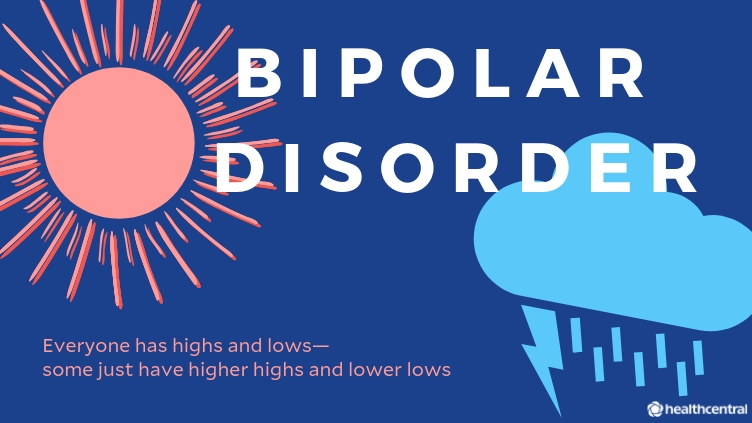
Myths and Facts About Bipolar Disorder

Bipolar disorder - Wikipedia
Augmentative dopaminergic interventions for treatment-resistant bipolar depression: a focus on dopamine agonists and stimulants

Prescription stimulant misuse, abuse prevalent among adults with ADHD
Posting Komentar untuk "stimulants and bipolar disorder"